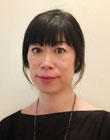Miya-Collab Never Forgetting the Great East Japan Earthquake--A Collaboration Project by Dedicated Chuo University Students
Yuri Komuro
Professor, Faculty of Law, Chuo University
Area of Specialization: Applied linguistics and English lexicography
1. Introduction
Chuo University's Homecoming Day event will be held this weekend (September 29) at the Korakuen Campus. Every year, student organizations that are officially recognized by Volunteer Center participate in the event by reporting their activities through photo exhibitions and by showcasing local products from the regions they support. Hamagiku-no-Tsubomi is a group that is active in Miyako, Iwate Prefecture. They will showcase their Miya-Collab products that they put their hearts and souls into at the customary local product exhibition. They will sell baked donuts from Tanaka Kashiho, a well-established confectionery store, in the package featuring Chu-Oji, the university's mascot. I asked three of the students who led this project about their activities and their thoughts on the Miya-Collab.
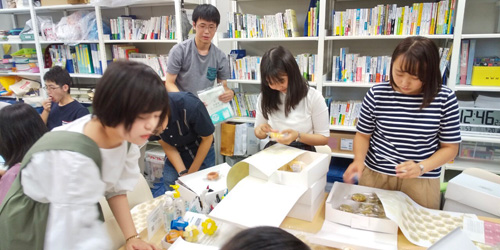
Students putting Miya-Collab design stickers on the products that will be sold at the Homecoming Day event
2. Hamagiku-no-Tsubomi and the Local Product Exhibition
Why does Hamagiku-no-Tsubomi focus on hosting local product exhibitions in Tokyo, as well as directly supporting communities?
- Akira Hidaka(Senior, Faculty of Letters) :
- As we were conducting activities in Miyako, we frequently heard many people voice their concerns that they and the suffering they faced will be forgotten. We thought about what we could do to inform people in Tokyo of the present situation of far-off Tohoku region. We decided that one thing we could do as Hamagiku-no-Tsubomi was to start a local product exhibition in Tokyo. We wanted to become a bridge between Miyako and Tokyo.
- Izumi Tsukui (Junior, Faculty of Law) :
- We visited various local businesses in Miyako, and asked about how it was in the immediate aftermath of the earthquake, and about the recovery process. Some lost their workplaces to the earthquake, others lost machinery, and many businesses considered closing due to the damage. However, even in these times of hardship, where day-to-day survival was a struggle, these business owners never failed to support others around them, and made steady efforts to do what they could to help others in the region who were facing similar struggles, and helped each other reopen their businesses. We want to communicate this dedication to others.
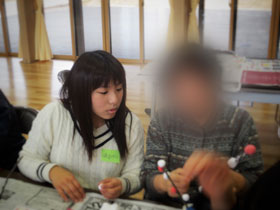
Akira Hidaka crafting New Year decorations with locals at the Tsugaruishi Public Hall in the winter of 2016
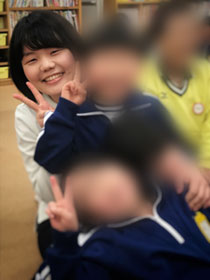
Izumi Tsukui volunteering at the Kuwagasaki Children's Home in the spring of 2019
3. The Birth of Miya-Collab
Why did you want to start a new collaboration project?
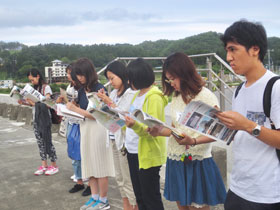
Shuhei Yama (on the furthest right) participating in a disaster preparation tour in the Taro district of Miyako, Iwate Prefecture in the summer of 2016
- Shuhei Yama (Senior, Faculty of Commerce) :
- The goal of the local product exhibition was to convey the status of Miyako's recovery and the feelings of the locals, as well as the important lessons that were learned in the aftermath of the Great East Japan Earthquake. However, as we repeated, we strongly felt our activities were losing our original purpose and instead becoming a mere business that only strives to make sales for a contribution. We wanted an opportunity to reconsider our organization's activities.
- Hidaka :
- I thought it would become a powerful opportunity to convey what we felt through our experience in the region, including the harm caused by the Great East Japan Earthquake and what unfolded in the aftermath.
4. Baked Donuts by Tanaka Kashiho Featuring Chu-Oji
The owner of Tanaka Kashiho, who agreed to create the collaboration package says "it would be great if our shop could become a place where those who relocated to upland areas and those who live in the same houses as before could come and communicate together. We decided to start making sweets again for the local people."
- Tsukui :
- We have had the pleasure of visiting Tanaka Kashiho on many occasions. They are always thinking about their customers. Anything that is thoughtfully made for others has a kind of fond nostalgia and warmth.
What made you want to choose Tanaka Kashiho's donuts?
- Hidaka :
- It is because we wanted students to be the target customers of the collaboration product. When we were thinking about to whom we want to communicate the charms of Miyako through the local product exhibition, we decided that students our age would be the easiest to approach, and they would be the most willing to spread the charms of Miyako together with us. We narrowed down the product candidates based on whether they are appealing and affordable for students, and decided to sell donuts. After asking students and faculty members around us how much they would buy our donuts for, we decided to set the price at 200 yen per donut, which we believe is a great price, considering they are additive-free.
The design of the stickers featuring Chu-Oji and the hamagiku, which is the city flower of Miyako, is delightful. How did you decide on the design?
- Yama :
- We wanted Chuo University students, who we are the closest to, to take an interest in our product, so we decided to use Chu-Oji, the popular mascot that is well-known to all the students here. At first, when we incorporated all the messages we wanted to communicate in the design, we were told that there was too much information, and that they couldn't see what the core concept was. We conducted a survey of over 100 people, and even got advice from a designer through our connections, which led us to reconsider the priority of the information we wanted to communicate and revise the design. It was a challenge integrating the feedback we received with the ideas we had that we didn't want to compromise for our design, but we were able to reaffirm what we wanted to communicate the most, and created a design we were satisfied with.
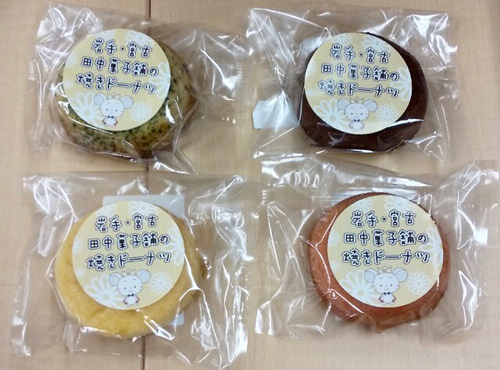
Clockwise from the top-left: wakame (seaweed), cocoa, strawberry, and plain flavor
5. Conclusion
In closing, please tell us about your thoughts on the local product exhibition at the Homecoming Day event, and your collaboration product, the baked donuts.
- Hidaka :
- We don't just want to convey our thoughts on the Great East Japan Earthquake. We also want as many people as possible to learn more about the brighter sides of Miyako, including its delicious food, its beautiful sites, its many charms, and hardworking local businesses. We hope that through our efforts, people will become more interested in Miyako, take trips there, and buy products online from businesses there. We hope to create more connections between people and Miyako through our Miya-Collab products.
- Tsukui :
- We will be selling our products on the first floor of Building 3 at the Chuo University Korakuen Campus from 1 p.m. to 4:30 p.m. We will also be selling a four-piece set that includes the plain, strawberry, cocoa, and wakame (seaweed) flavors. The wakame (seaweed) flavor is made using Masaki wakame, a local specialty of the Taro district, and has a sweet flavor with a slight, pleasant salty aftertaste. We really recommend this one even if you are not big on sweets. We hope you will come and try it. Part of the sales goes toward maintaining the memorial remains of the Taro Kanko Hotel that was destroyed in the earthquake.
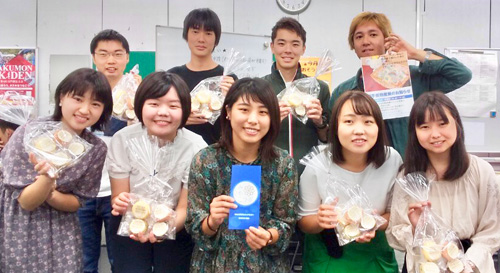
Members of Hamagiku-no-Tsubomi and Miya-Collab
Student activities like these are made possible through the continuous support of GAKUVO and all of the alumni members. In closing, I'd like to offer my heartfelt gratitude for your support.
- Yuri Komuro
Professor, Faculty of Law, Chuo University
Area of Specialization: Applied linguistics and English lexicography - Yuri Komuro graduated from Japan Women's University Faculty of Humanities in 1993. In 2009, she earned her doctorate in lexicology from the University of Exeter in the UK. She became a full-time lecturer at the Chuo University Faculty of Law in 2005, and assumed her current post in 2017. She is a member of the European Association for Lexicography and the Asian Association for Lexicography, among other associations. She was involved in the writing of the Lighthouse English-Japanese Dictionary, the Compass Rose English-Japanese Dictionary, among other texts.
